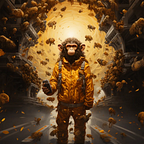Obsidian — My Digital Brain
Why do I use Obsidian?
We live in an incredible time of human history where most of our collective knowledge is just a few clicks away.
The only limit to our learning is our own motivation, not access to information
At the start of covid, as we were all locked inside, I, like many of you, had a lot of extra time on my hands. I decided to explore the world of podcasts, books, and YouTube videos, only to find myself quickly becoming lost in a labyrinth of rabbit holes. It became very clear to me that I needed to have a proper system in place for organizing and leveraging the vast amount of knowledge I have been tapping into.
Before committing to a tool, I first wanted to understand how we as humans store and retrieve knowledge. Note that our brains do not simply retain a list of facts, but rather have a thematic understanding that connects different insights. The more connected a piece of knowledge is, the easier it is to retrieve and apply in our lives. Elon Musk’s analogy is a useful way to think about this concept:
it is important to view knowledge as sort of a semantic tree — make sure you understand the fundamental principles, ie the trunk and big branches, before you get into the leaves/details or there is nothing for them to hang on to.
While we all have our own unique knowledge trees, unfortunately, most information today is delivered in a standardized few-to-many approach. We are presented with a bunch of leaves, but that’s where it stops.
With this in mind, I set out to actively create a digital version of my own knowledge tree. In other words, attaching the leaves to existing branches instead of simply shoving them in a drawer. Enter Obsidian, the powerful knowledge base that allows just that.
Obsidian offers a variety of benefits, but the three most important ones to me are the following. First, its ability to link ideas together. Second, its flexibility in allowing me to create my own setup and workflow. Thirdly, its open-source nature and the fact that the nodes are stored locally as plain text files. This means that my knowledge tree can’t be held hostage by the platform, and I can easily move to a different system if I later choose to do so.
How do I use Obsidian?
I use Obsidian in conjunction with the Zettlekasten system for capturing temporary notes from podcasts, articles, videos, and conversations, and my own summarization technique for books. These ideas and summaries become nodes or leaves that I can easily link to each other, gradually forming branches and ultimately a tree.
Back to the Zettlekasten system. For those that are unfamiliar with it, this is a popular note-filing system. One where you capture temporary rough notes and over time distill them and turn them into permanent insights. I use WhatsApp to send myself those brief fleeting notes whenever I hear something interesting or have a train of thought I’d like to capture. A couple of times per week I then go through those notes and turn them into core ideas within Obsidian. While moving those ideas over to Obsidian, I reflect on how they fit within my existing knowledge and link them accordingly.
For books on the other hand It took me a while to find the perfect workflow to capture the insights. There are a couple of points that I wanted to optimize for. First and foremost, I want to enjoy the act of reading a book. I don’t want to be distracted by highlighting, and taking notes on every page. Moreover, I want actionable insights from my readings. And as you would expect, I want those insights to connect with what I have read before.
To achieve this, I created an Obsidian template that I fill out after finishing a book. This allows me to fully enjoy the read without any distractions. The core idea behind this template is that within ~10min I’m able to summarize the book through four different lenses — away to really cements the main insights:
- One-sentence summary → Get to the core idea
- Main ideas → Bulk of the content, this often turns into several leaves
- A picture → Visual description of how I would summarize the picture into one painting (And yes, I tend to also prompt those into DALL-E 2)
- What I incorporate in my life → One or two bullet points of actions I am going to incorporate into my daily routine. I had to learn the hard way to really condense this section. When turning it into a large wish list I can almost guarantee that nothing will be incorporated
What does my Obsidian look like?
One year, 69 books and countless hours of podcasts, led to 446 ideas — some more entangled than others.
The bigger the node, the more other nodes link to it. Putting it another way, they can be seen as larger branches in the knowledge tree analogy. The color coding is not random, but refers to six types of nodes:
- Red =ideas
- Dark Blue = People
- Yellow = Books
- Turquoise = Map of Content (Moc) e.g. Philosopy, Neuroscience,..
- Purple = Cogs of time e.g. Supercycles in the market, pieces of knowledge with a shorter shelf-life
- Green = My core lenses to understanding life
There is only one green dot. A dot that connects to my core lenses through which I try to view life. The beauty is that these lenses are emergent out of the knowledge tree. They are the thickest red nodes. In other words, those ideas are most referenced by other nodes in Obsidian. They are the large fruits that my tree has grown.
